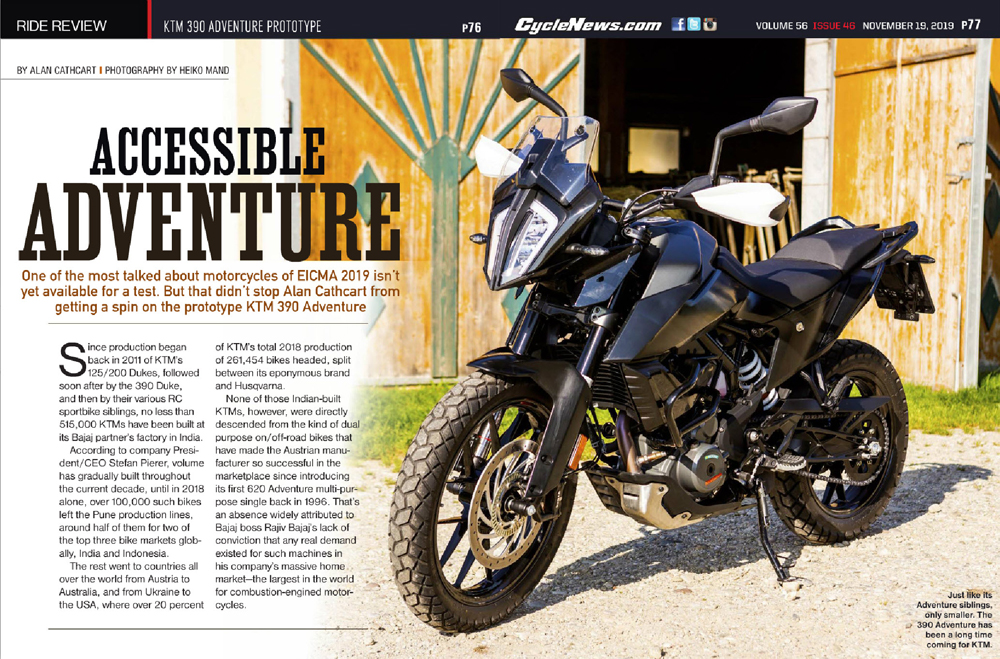Alan Cathcart | November 22, 2019
KTM 390 Adventure Prototype Review
Alan Cathcart, our European correspondent had the opportunity to ride the KTM 390 Adventure prototype in November 2019 and provided the story below. We received our first production version in April 2020 and posted our 2020 KTM 390 Adventure review here.
One of the most talked-about motorcycles of EICMA 2019 is not yet available for a test. But that didn’t stop Alan Cathcart getting a spin on the KTM 390 Adventure prototype.
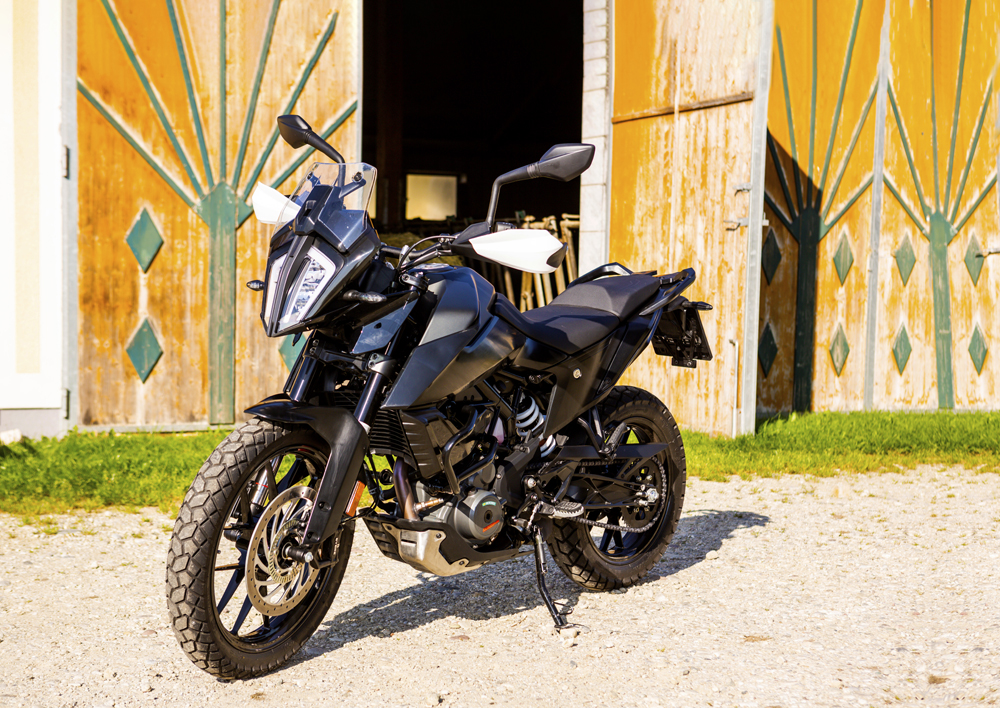 Just like the brothers, only smaller. The 390 Adventure has been a long time coming for KTM.
Just like the brothers, only smaller. The 390 Adventure has been a long time coming for KTM.
Photography by Heiko Mand
Since production began back in 2011 of KTM’s 125/200 Dukes, followed soon after by the 390 Duke, and then by their various RC sportbike siblings, no less than 515,000 KTMs have been built at its Bajaj partner’s factory in India.
According to company President/CEO Stefan Pierer, volume has gradually built throughout the current decade, until in 2018 alone, over 100,000 such bikes left the Pune production lines, around half of them for two of the top three bike markets globally, India and Indonesia.
The rest went to countries all over the world from Austria to Australia, and from Ukraine to the USA, where over 20 percent of KTM’s total 2018 production of 261,454 bikes headed, split between its eponymous brand and Husqvarna.
None of those Indian-built KTMs, however, were directly descended from the kind of dual purpose on/off-road bikes that have made the Austrian manufacturer so successful in the marketplace since introducing its first 620 Adventure multi-purpose single back in 1996. That’s an absence widely attributed to Bajaj boss Rajiv Bajaj’s lack of conviction that any real demand existed for such machines in his company’s massive home market—the largest in the world for combustion-engined motorcycles.
That’s despite the challenging road surfaces found throughout India, which a street Enduro’s longer-travel suspension would ideally cope with, and the traffic-clogged cities through which a taller seat height is beneficial in helping plot a course—let alone the glorious adventure riding possibilities throughout the sub-continent. One can only conject that the advent in the past two years of the 411cc Royal Enfield Himalayan and Indian-built BMW G310 GS may have helped change his mind—that, and Stefan Pierer’s talents for persuasion.
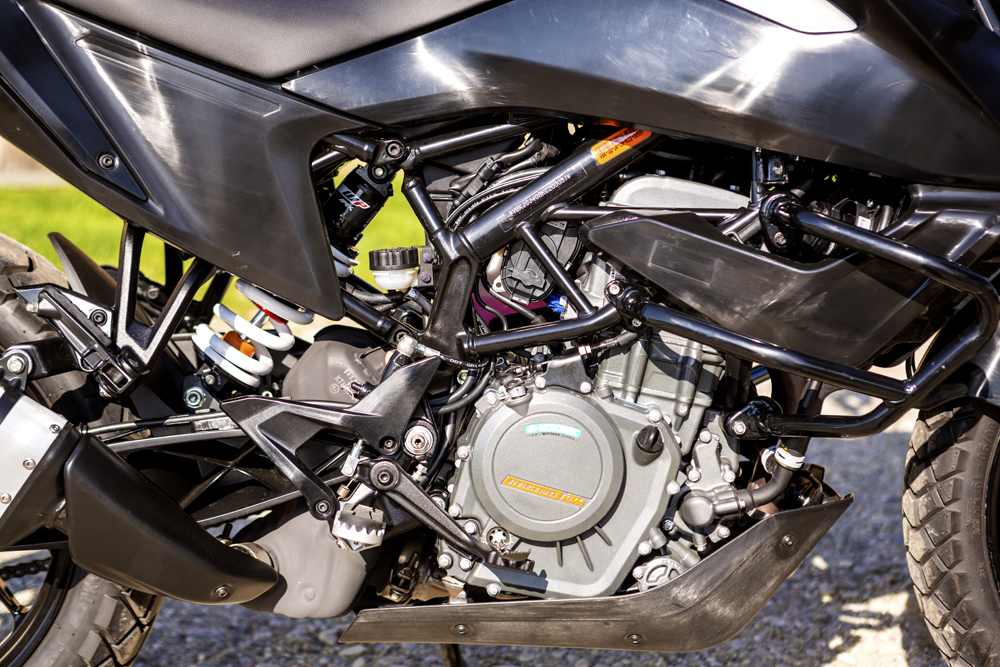 Slotting the 372cc motor into the Adventure chassis will make for three models in the 390 range—Duke, 390R and Adventure.
Slotting the 372cc motor into the Adventure chassis will make for three models in the 390 range—Duke, 390R and Adventure.
For that absence is now being addressed, with the launch at this year’s EICMA Milan Show of the first small-capacity KTM go-anywhere bike, the 390 Adventure due to hit dealer showrooms in March next year, which while primarily developed in KTM’s R&D Center at its Mattighofen HQ, will be entirely manufactured in India.
While using the 390 Duke as a platform, its distinctive design is also derived from the company’s dominant KTM Rally bikes, which have won the iconic Dakar race for the past 18 years in a row. Indeed, it can justly be claimed that with such Rally events limited to 450cc bikes since 2011, the 390 Adventure is more closely related to KTM’s serial race-winning off-roaders than its larger-capacity parallel-twin 790 Adventure and V-twin 1290 Super Adventure models are.
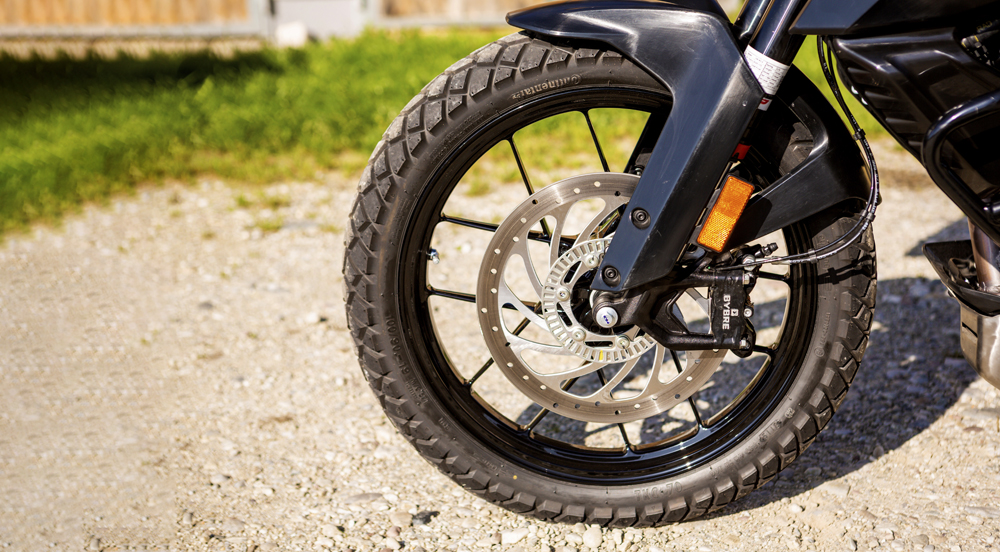 Bybre’s trusted four-piston caliper is matched to ABS that contains the KTM Off-road setting that disengages the ABS on the rear.
Bybre’s trusted four-piston caliper is matched to ABS that contains the KTM Off-road setting that disengages the ABS on the rear.
The chance to be the first outsider to ride the pre-production version of the new model some weeks before its EICMA launch, unveiled a bike which promises to be a genuine multi-purpose entry level motorcycle, rather than a lookalike styling exercise or a neo-retro nostalgia bike.
“We’d been talking about producing an Adventure-based on a Bajaj-built model for many years, but there was not much appreciation or acceptance of this on their part,” says KTM’s Senior Product Manager Offroad & Adventure, Joachim Sauer. “Finally, though, there was so much demand for a smaller Adventure, especially from our emerging markets, that we developed a concept bike here in Austria which we were prepared to put into production ourselves with engines sourced from India, even if the price would inevitably be higher.
“But in the end, we managed to convince Bajaj to make an affordable all-rounder with a smaller engine based on the 390 Duke. It offers all the major attributes of its bigger sisters, including electronic rider aids, while providing easier rideability due to its lower weight and less demanding engine characteristics, all combined with lower purchasing costs thanks to being built in India.” Sauer wouldn’t disclose yet what the new bike will be priced at, but he’s also responsible for overseeing the development of an even smaller capacity KTM 250 Adventure model set to reach showrooms later next year, as an even more affordable but still nevertheless full size Enduro all-rounder using the same platform as the new 390 model, but built to a lower spec with non-adjustable suspension damping, etc..
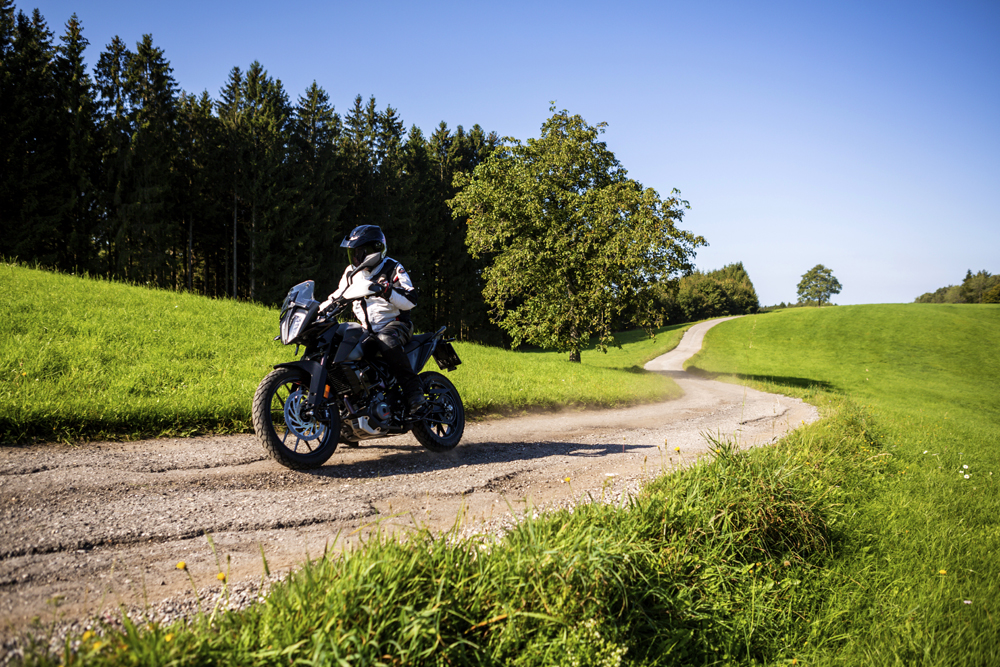 Insert this into Indian traffic and you’ll have an excellent machine at your disposal.
Insert this into Indian traffic and you’ll have an excellent machine at your disposal.
Testing the KTM 390 Adventure Prototype
My chance to find out how well it performed in real-world riding came by following two-time European Enduro champion and ISDE Vase winner Joachim Sauer on a 75-mile tour of the glorious Upper Austrian countryside in KTM’s backyard, including a good stretch of gravel road and just a dash of genuine off-roading. I’m 5’10” tall and the bike felt uber-comfortable once I’d stood on the left footrest to hoist myself aboard, to find that taper-section handlebar had been pulled back ideally for a super-controllable stance. The seat narrows nicely where it meets the fuel tank to help make you feel at one with the bike, as well as put a leg down at rest, and although its padding is pretty firm, for my short ride on tarmac I had no complaints from my posterior.
But the most immediately noticeable thing was that the 390 Adventure is a proper full-size motorcycle, arguably even more so than its 390 Duke sister bike. It feels substantial and spacious, thanks also to the lower-mounted footrests, which aren’t however low enough to become an issue in terms of ground clearance. Yet paradoxically it also feels light-steering and easy to ride off-road, especially on the high-speed gravel tracks Joachim led me along, where switching to the Off-road ABS helped give a sense of real control. This bike is more than merely safe to ride in the dirt for the less experienced—it’s also fun! But transferring to tarmac proved it to be a true dual-purpose model, that’s both stable in fast, sweeping turns despite the skinny 100/90-19-inch front tire, yet agile and eager to change direction almost before you’d thought of doing so in swooping from side to side through a series of curves.
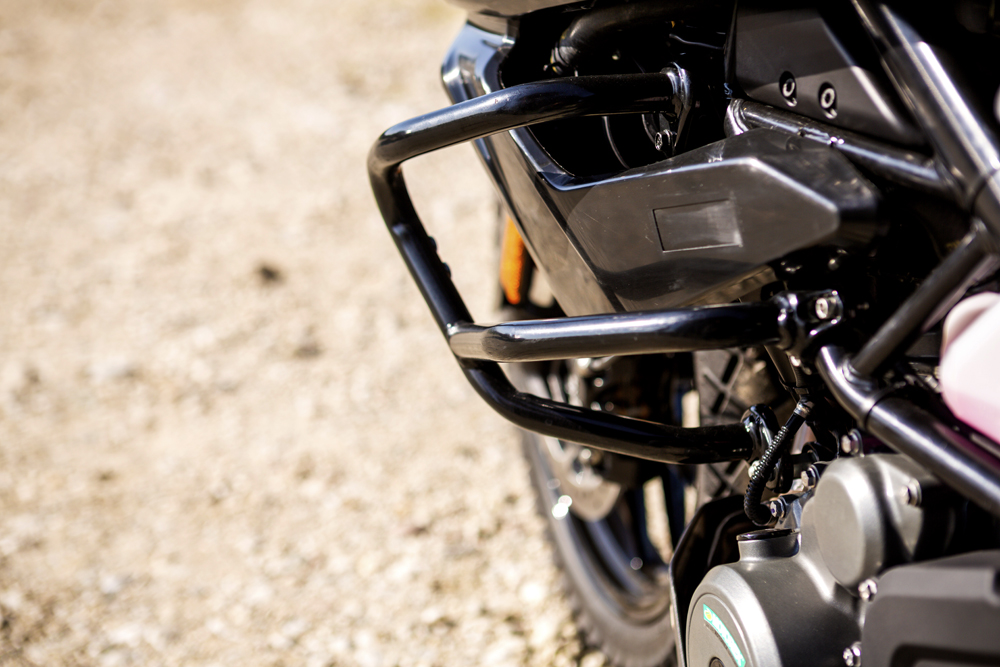 Solid crash bars are a welcome addition to the 390.
Solid crash bars are a welcome addition to the 390.
I hadn’t ridden the Korean-made Continental tires before, but they gave heaps of confidence thanks to the way their smoothly graduated profiles delivered a sense of predictability when changing direction at any speed, while in tighter turns I became increasingly more impressed with the level of grip at both ends. So I could trail brake into the apex of successive hillside hairpins without the ABS cutting in too obviously, then power out of them in a way that was quite unexpected for a 44 bhp motorcycle. That’s because the lean angle sensitive TC’s chosen setting and the surprising amount of grip from the chunky block-tread rear tire let me get hard on the throttle while still leaned over in a way I’d have been impressed with on a Supermono road racer. Improbable, or what?! It seemed the harder I rode in pursuit of Herr Sauer the stickier the tire became and the better the grip I had, without any trace of the tire squirming. And arguably even more surprisingly, there was little hint of the tires drumming when running along straight stretches of tarmac, like some other much noisier such dual purpose knobbies will do.
I was equally impressed with the 390 Adventure’s WP suspension package, which thanks to the extensive wheel travel at either end offered a welcome degree of suppleness allied with control over lumpy, bumpy, frost-ravaged mountain roads. I reckon this will be a plush ride in Indian road conditions! That big front brake didn’t grab, even when I used it increasingly less gingerly on gravel, before I realized fully how well the off-road ABS is set up, while on tarmac it delivered benchmark braking by entry-level standards—yet this won’t frighten newbies, and the rear brake has lots of feel off road, too.
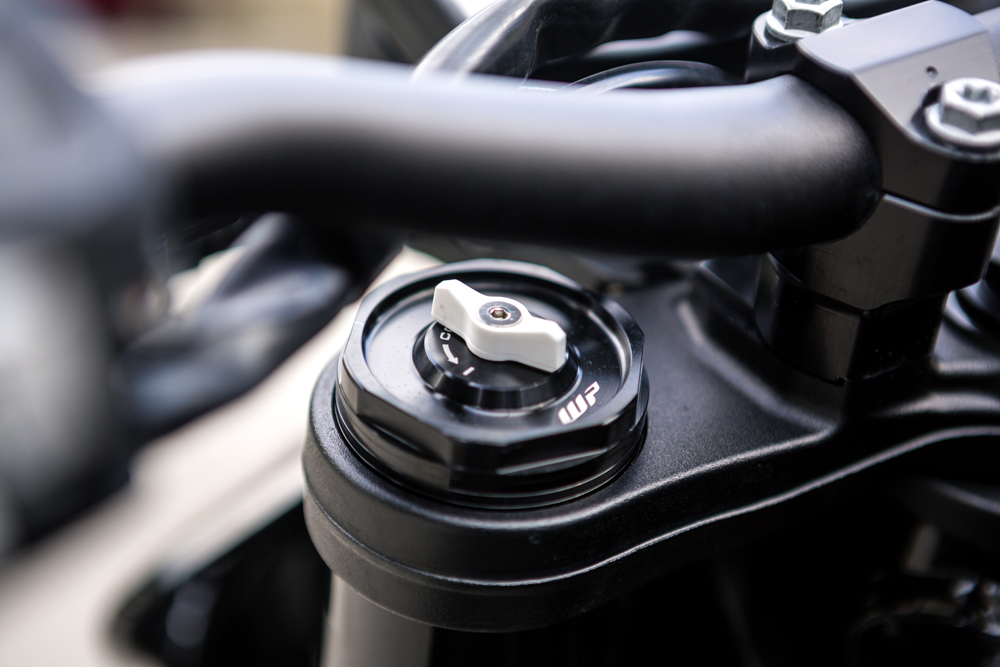 Front suspension gets adjustable rebound and compression damping, but not preload adjustment.
Front suspension gets adjustable rebound and compression damping, but not preload adjustment.
But that great engine I was already well familiar with from streetbike use in the Duke and RC variants is a key ingredient in what makes this such a good motorcycle, and anyone who’s ridden the 390 Duke will know how good a motor it is. It whirrs instantly into life at the thumb of the starter button, before delivering really punchy acceleration up through the gears, though you must keep it revving above 4,000 rpm for smooth pickup on a wide-open throttle without any trace of transmission snatch. With 30Nm of torque already on tap at 6000 rpm, you don’t need to use the smooth-shifting six-speed gearbox too hard, though this has a light, progressive-action clutch that feeds out very controllably in city use. And both the clutch and brake levers are adjustable—not something you see on other such entry level products
Elsewhere, the optional two-way powershifter was perfectly set up with just the right amount of pressure needed to operate it in either direction, and this is hugely advantageous off road, too—you have a greater sense of control when you don’t have to use the clutch on loose surfaces, but can hold on tight to the handlebar grips to steer your way out of trouble. Revs mount steadily rather than hurriedly, though, but up above 6000 revs acceleration is even more zestful, and there’s a good sense of flywheel effect, with a long-legged feel to its performance which is unexpected for an engine with just 375 cubes, thanks to what seems to be a very flat torque curve. Roll-on response in the higher gears is quite good, and immediate, without needing to hook down a ratio and rev it hard to get any sense of zest—a crucial feature in many markets, where riders resist using revs to save fuel, and so get used to short-shifting all the time.
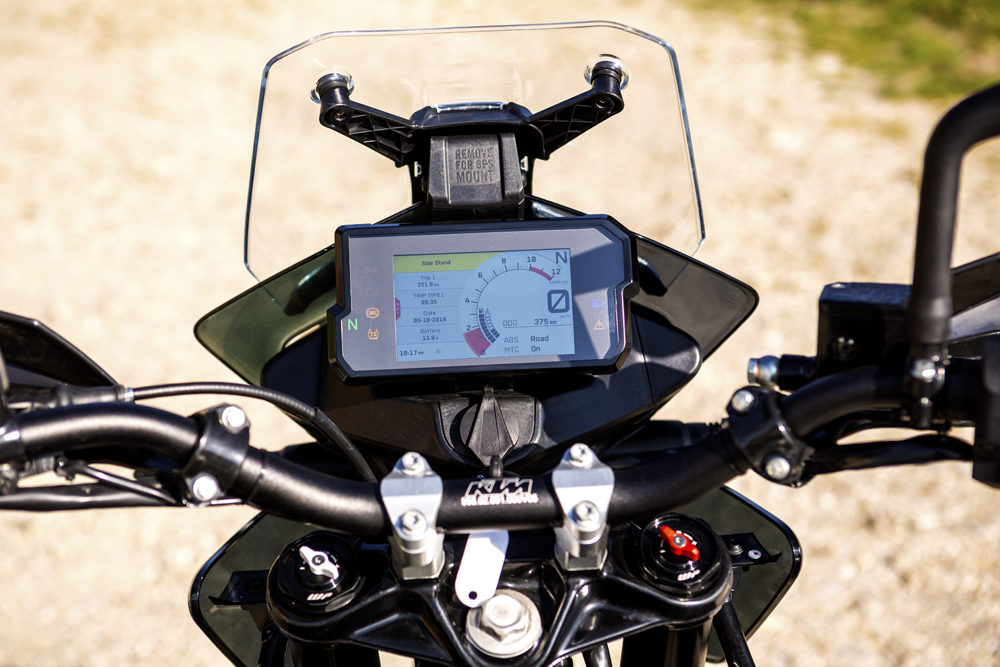 The same dash found in the previous-generation Super Duke is fitted to the 390 Adventure.
The same dash found in the previous-generation Super Duke is fitted to the 390 Adventure.
This super-flexible eager-revving engine’s performance makes the 390 Adventure invigorating to ride, with it literally pulling off its 1300 rpm idle speed mark without excessive use of the light-action clutch—this is an excellent town bike. It’s pretty forgiving as well as torquey, with a totally linear acceleration all through the rev band, with that extra little kick above 6000 rpm when revs start to pick up a bit faster. There’s no vibration at any speed, thanks to the counterbalancer doing its job, and also no need to flirt with the soft-action 10,200 rpm limiter—I shifted up at 8000 rpm in the gears, and didn’t seem to sacrifice momentum. But this is also a surprisingly fast 373cc motorcycle—8200 rpm in top gear produced 93 mph on the digital speedo, tracking dead straight and still with no undue vibration, and with pretty good protection from the windscreen in its higher setting
In the ultra-accessible 390 Adventure, KTM and its Bajaj partner have together produced what’s likely to be a very significant motorcycle in the global marketplace. This is a small(er)-capacity full-size motorcycle which punches way above its weight, and in doing so is certain to bring the wide-open world of adventure touring to a vast new audience in terms of age, income and/or nationality. This is the modern-day version of the first Yamaha Ténéré XT600Z which essentially invented adventure biking back in 1983 when it was first produced. It’s that significant a model – and just wait until you ride it, before telling me I’m wrong…
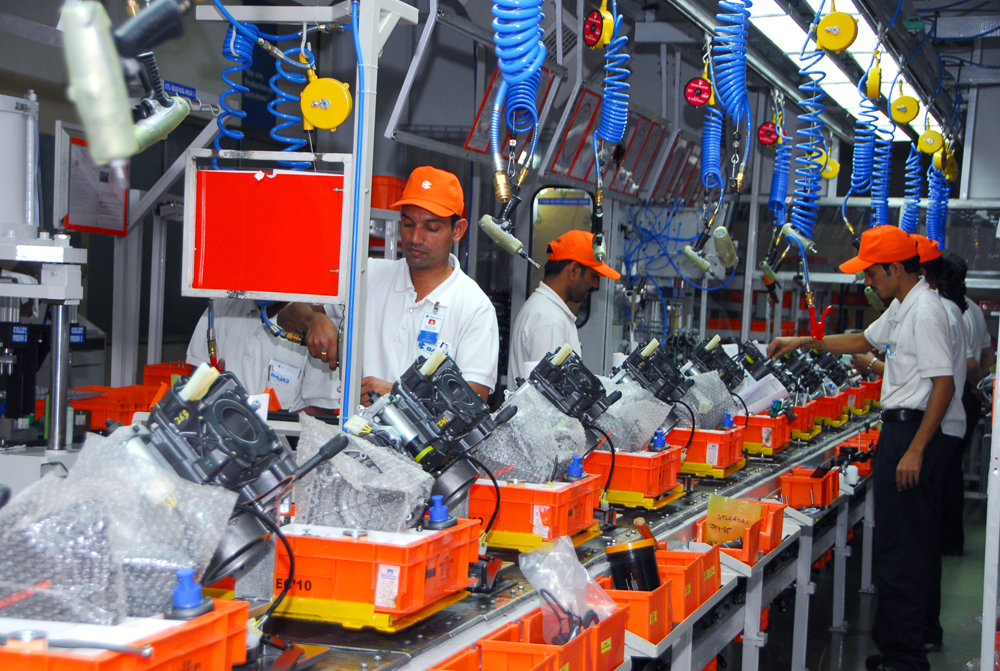 The Bajaj factory in India pumps out more motorcycles than almost anyone else on the planet.
The Bajaj factory in India pumps out more motorcycles than almost anyone else on the planet.
Build it and they will come
To create the 390 Adventure KTM has essentially employed the same broad platform as the 390 Duke, especially its mechanical package which is relatively unchanged, but with its chassis extensively modified for dual-purpose potential. “We’ve tried to use the 390 engine to make a proper small displacement Enduro for the entry level segment, that’s a full-size motorcycle, not a kid’s bike,” says 390 Duke Project Leader Michael Landsiedl. “Our objective was to make an affordable all-rounder with truly versatile performance both on and off road. It had to be made for everyday riding on the street, with proper space for a passenger, but also had to have genuine off-road capability on all kinds of terrain, and especially on dirt roads.”
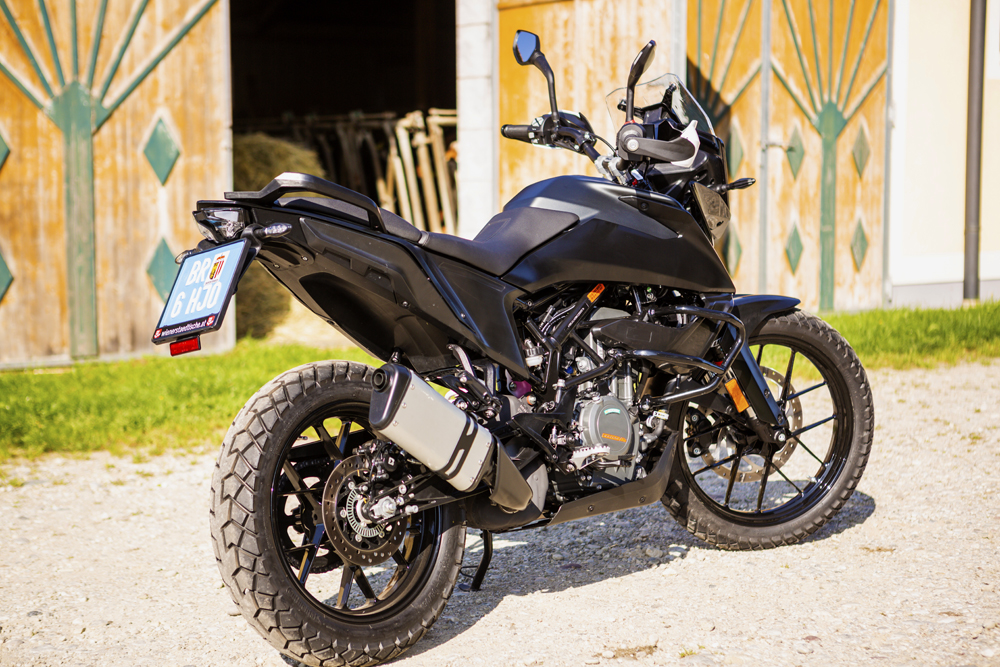
This means the liquid-cooled 373cc four-valve motor running a high 12.6:1 compression and measuring 89 x 60mm with chain-driven DOHC and DLC-coated finger followers, plus a single gear-driven counterbalancer, delivers the same 44 horsepower at 9000 rpm as in the 390 Duke (so is suitable for A2 EU licence holders). Maximum torque of 27.29 lb-ft is delivered at 7000 revs, in a bike weighing 348 pounds dry, or 379 with a full 3.83-gallon fuel load that offers a range of over 250 miles, according to Landsiedl.
That’s despite the addition of twin catalytic converters in the stainless steel exhaust, which will allow the already Euro 4 compliant new model to meet the forthcoming much stiffer Euro 5 emission norms. The cooling system is all-new, with a curved radiator and dual fans. “We’ve tried to keep the rider comfortable even in extreme conditions by keeping temperatures down,” says Landsiedl. The same six-speed transmission with cable-operated oil-bath slipper clutch from the Duke is retained here, but with the Quickshifter + two-way powershifter fitted to my test bike only available as a KTM Powersports option.
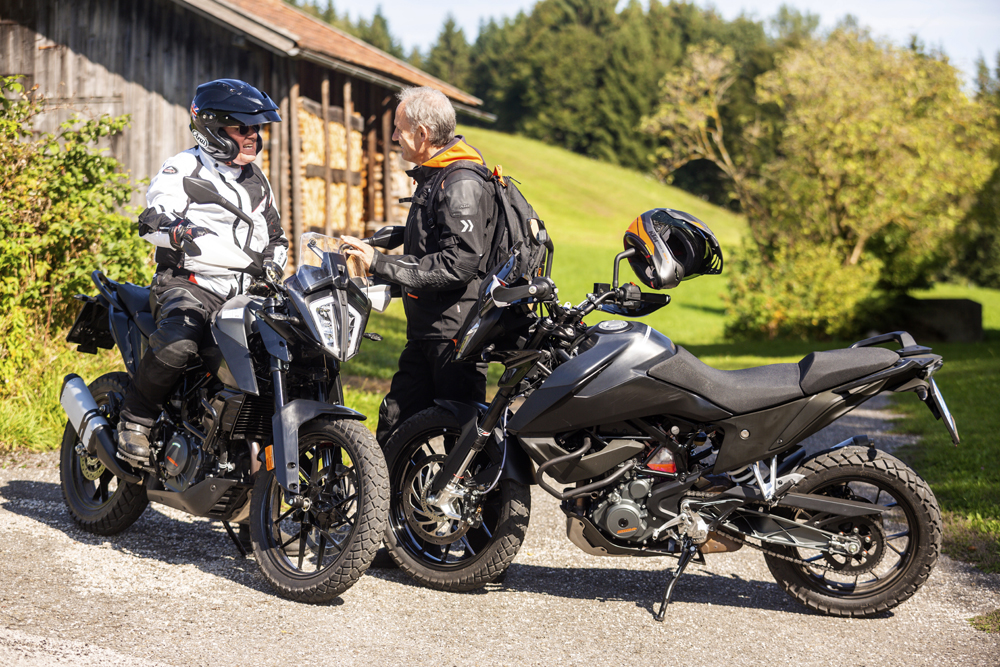 KTM’s Senior Product Manager Off-road and Adventure, Joachim Sauer, chats with Alan for his views on his new baby.
KTM’s Senior Product Manager Off-road and Adventure, Joachim Sauer, chats with Alan for his views on his new baby.
The 390 Adventure’s Bosch ECU offers ride-by-wire control of the 38mm Dell’Orto throttle body, whose airbox is mounted under the seat to help deliver a lower seat height and more compact packaging, and has been remapped for more versatile on/off-road use, albeit still with just a single riding mode. Switchable lean angle sensitive traction control comes as standard, together with Bosch’s 9.1MP Cornering ABS which can be switched to Off-road mode if needed, whereby ABS is deactivated on the rear wheel and reduced on the front, with data from the lean angle sensor no longer active. This allows you to lock up the rear wheel to steer into turns if you’re expert and/or brave enough, while reducing the front wheel’s ABS effect on loose surfaces, so providing more stopping power while offering more secure braking in the dirt. “The ABS settings have been developed to ensure maximum braking power and minimal intrusion,” says Landsiedl.
This engine is installed as a fully stressed member in a tubular steel trellis frame with detachable subframe that KTM claims to be derived from its Dakar-winning 450 Rally, though its wet sump format means the taller motor inevitably sits higher relative to the wheel axles in the 56.3-in wheelbase. This makes the frame design closer to the updated 2017-onwards 390 Duke chassis, but with a 15mm longer cast aluminum swingarm to give space for deeper section off-road tires if necessary. Continental’s well-proven TKC 70 tubeless dual-purpose rubber is fitted as standard to what are claimed to be extra robust 19in-front/17in-rear cast aluminum wheels specifically designed for off-road use. The large 320mm single front brake disc with four-piston radial caliper speaks clearly to the bike’s dual-purpose nature, with a 230mm rear with twin-piston floating caliper. These are street brakes produced by Brembo’s ByBre Indian subsidiary, so the Off-road ABS will be a welcome feature for less experienced off-roaders.
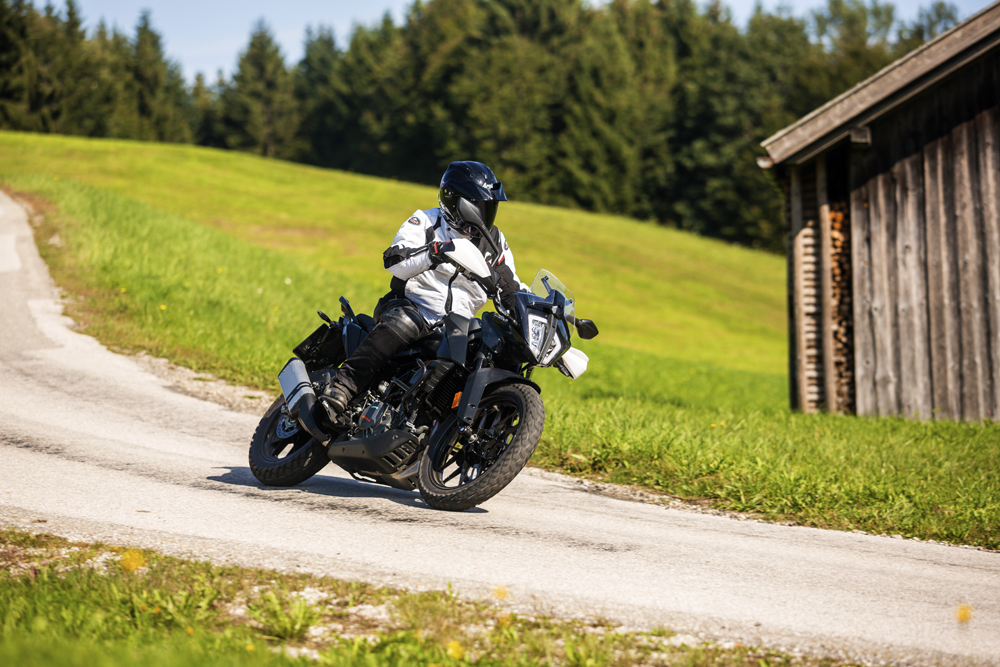 The 390 Adventure will provide a brilliant gateway into the world of adventure riding for a whole generation that may not have even considered it.
The 390 Adventure will provide a brilliant gateway into the world of adventure riding for a whole generation that may not have even considered it.
However, for an entry level go-anywhere bike the 390 Adventure’s specially-developed WP APEX suspension is pretty upmarket, with the direct-action cantilever rear shock that’s adjustable for spring preload and rebound damping delivering 6.97 inches of wheel travel. Up front, the 43mm upside-down fork set at a 26.5° rake with 3.86 inches of trail and giving 6.69 inches of travel is fitted with compression damping only on the left and rebound on the right, each adjusted via a dial on the top of the leg. This overall package delivers a 33.66-inch seat height, although there’s an optional suspension lowering kit including a shorter side stand (there’s no centerstand) to reduce that by 25mm, as well as two choices of seat options (including a one-piece Rally design) which lift it either 10mm or 20mm higher. The standard seat comes in two parts for extra passenger space, with a small storage compartment beneath the rear section.
There’s heaps of luggage options for city or dual purpose use, while the crash bars fitted to my test bike are standard in India (same as the missing sari-guard!) but optional elsewhere, though the hand guards are standard everywhere. The very high spec for an entry level model also features LED lights front, rear and for all direction signals, with the headlight incorporated in KTM’s distinctive ‘mask’ styling for the bike’s front pod. This incorporates a two-position adjustable screen, though you need a screwdriver to vary it by 40mm either way. The 390 Adventure also comes equipped with an easily readable full colour five-inch TFT dash which automatically adapts to variations in light conditions. The menu switch on the left side of the taper-section aluminum handlebar lets you change ABS or TC settings and scroll through the screen info, while you can connect your smartphone to the bike via the optional KTM MY RIDE system, as well as select turn-to-turn navigation via the app. Nothing stays still, of course, but at present this makes the 390 Adventure likely to stand out as by some way the best equipped entry-level dual-purpose model from any manufacturer. CN
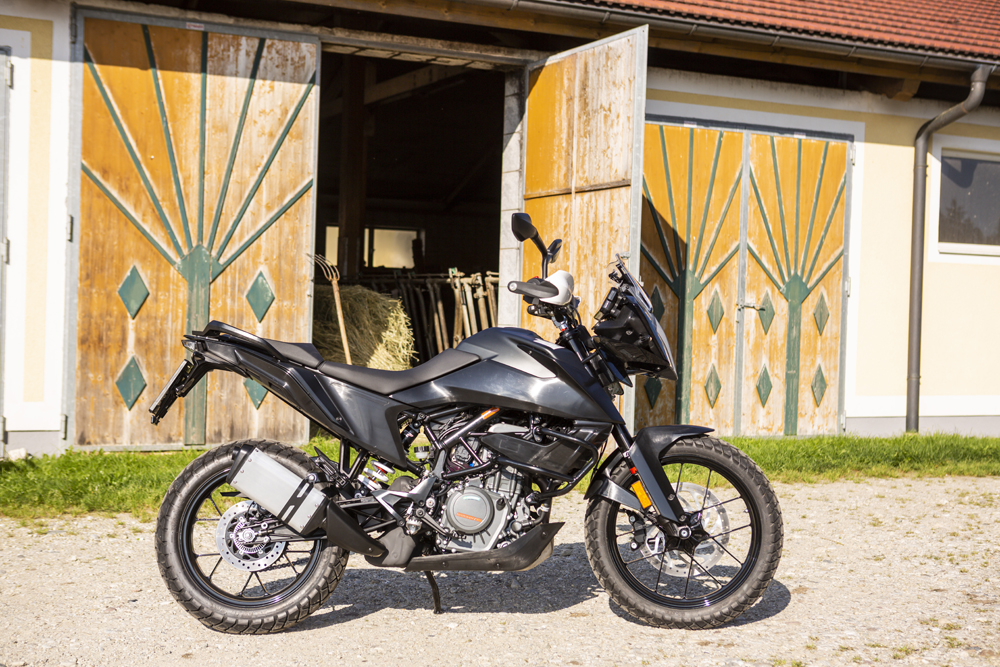
KTM 390 Adventure Prototype Specifications
| Engine: |
Liquid-cooled single-cylinder, DOHC, 4 valves |
| Displacement: |
372cc |
| Bore x stroke: |
89 x 60mm |
| Compression ratio: |
12.6:1 |
| Fuel delivery: |
EFI |
| Transmission: |
Six-speed cassette |
| Clutch: |
Wet, multiplate |
| Chassis: |
Tubular steel trellis |
| Front suspension: |
43mm WP XPLOR fork, adjustable compression/rebound |
| Rear suspension: |
WP XPLOR Monoshock, adjustable rebound and spring preload |
| Front brake: |
Four-piston, radially mounted caliper, 320mm disc |
| Rear brake: |
Double-piston, floating caliper, 230mm disc |
| Front tire: |
100/90 x 19 in. |
| Rear tire: |
130/80 x 17 in. |
| Wheelbase: |
56.3 in. |
| Seat height: |
33.6 in. |
| Fuel capacity: |
3.83 gal. |
| Weight: |
379.2 lbs. |
